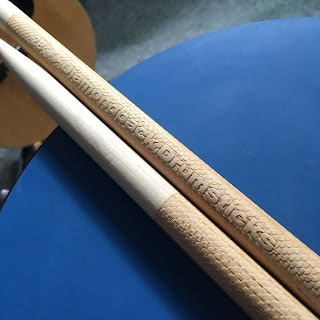For a short time in 2018, Gretsch produced a specialty "practice drum" and sold it through one dealer, the Memphis Drum Shop. It was an interesting but short-lived idea: A limited supply of the drums were made with a choice of either polished natural wood or a white marine pearl wrap.
At the time, I was somewhat skeptical: when I could make my own practice drum on the cheap from cast-off parts, why would I spend three hundred dollars on one?
But then, the drum disappeared as quickly as it had come on the market, in a little under a year. And all information about the drum disappeared from both the Gretsch and Memphis Drum Shop web sites.
I'd never seen one in person, and remained curious. Then, someone offered one online for sale at a reduced price, I was flush from the recent sale of a high-end bicycle, and felt like I might want to have one in my practice pad collection. The seller and I agreed on a price and it was mine.
When it arrived, it was in nearly-new condition. The natural wood finish was lovely to look at. The inside of the drum shell was painted gray and had a Gretsch sticker applied. The classic round badge was applied, and the rim was engraved or stamped with the Gretsch brand as well. In short, whatever this thing was, it was beautifully appointed.
From the Memphis web site (whose Marine Pearl version is shown at left), I was able to learn how the drum was constructed, and my model bore everything out:
(from the Memphis Drum Shop web site: "The 12" Gretsch USA Custom Tunable Practice Pad looks and feels like a
real drum. It’s perfect for practicing rudiments, snare pieces, and
rimshots. This drum features 5 Classic lugs, Gretsch 302 hoops, Gretsch
Round badge, and Remo Coated Ambassador drumhead. This practice pad has a
white marine pearl finish or natural wood with chrome hardware. Other Gretsch USA
Custom finishes available by special order.")
(Photo at left from Memphis Drum Shop)
Here are a couple of short videos demonstrating my practice drum with both sticks and brushes.
What I noticed right away is that, while the coated head does indeed provide the feel I like for brushwork, the muffling provided by the rubber pad means my brushwork sessions are VERY quiet. They're also a little restricted by the pad's 12-inch size; brush patterns utilizing the full surface of a 14-inch head will need to be readjusted for a smaller surface, which may or may not pose an issue for some players.
Playing on this surface with sticks doesn't really break any new ground for me; the surface sounds pretty much the same anywhere in or near the center of the head. Playing near the rim offers a reduction in vlume and a slight change in tone, but as this is a practice pad the whole point, is, well, chopping. I guess.
Honestly, the more I hang out with this thing, the less it seems to serve a genuine musical purpose and the more it seems to exist as a short-run vanity item. And so, unless I hear differently from Gretsch (to whom I've sent an email of inquiry), my initial skepticism was probably well-placed.
Still I am glad to have this in my collection. It's a beautiful oddity and that alone makes it interesting for me. If I hear back from Getsch, I'll update this post.
Happy drumming.









































